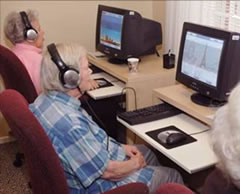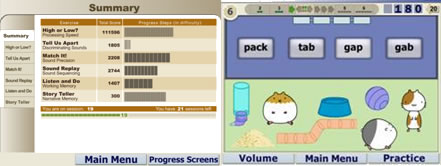Cognitive TrainingCurrent Trends and Propositions for the LLM service
The widely-documented age-related cognitive decline (e.g. Lusting et al, 2006; Mahncke et al., 2009) and the demographic trends which reveal that the earth’s population is growing and is expected to age further in the next decades (World Health Organisation) highlight the pressing social need for the design and evaluation of effective cognitive training programs that will maintain and improve older adults’ cognitive functions. To this end, several approaches have been used and a variety of computerized cognitive training exercises for senior citizens are now available.
Do they really work? Recently, Owen et al. (2010) have specified such a criterion: “The central question is not whether performance on cognitive tests can be improved by training, but rather, whether those benefits transfer to other untrained tasks or lead to any general improvement in the level of cognitive functioning” (Owen et al., 2010, p. 1). In our opinion, transfer of learning is, indeed, the most critical result that any successful cognitive intervention program should be able to demonstrate. If societies and individual seniors are going to invest time and money on demanding and effortful activities, then it is reasonable to expect that this effort will improve considerably their cognitive functions, mood and everyday living. In Owen et al.’s study (2010), viewers of a popular BBC series participated in a six-week online training program on various cognitive tasks (e.g. problem solving, reasoning, visuospatial processing etc). Different groups of participants were trained on different tasks. Results showed significant improvement in all the particular tasks they were trained with, but no improvement in neuropsychological tests assessing general cognitive functions of memory, reasoning etc. Despite the severe methodological flaws of this study (e.g. the minimum training period of ten minutes a day, three times a week was too short for any reliable effects to emerge), it is in agreement with previous studies who show learning for the trained tasks but fail to produce transfer outcomes to novel settings. For example, during strategy training interventions, seniors are directly taught putatively useful strategies in various cognitive processes such as memory, reasoning etc (e.g. Ball et al., 2002). These studies consistently show significant improvement in the trained and very similar transfer tasks but limited or no transfer of learning to different tasks and everyday activities (Lustig et al., 2009). To achieve substantial gains and robust generalization of learning, alternative approaches are required. A plasticity-based computerized training approach
The Brain Fitness Program is designed to speed up auditory processing, improve working memory, improve the accuracy and the speed with which the brain processes speech information and reengage the neuromodulatory systems that gate learning and memory. To reverse cognitive disuse and drive brain plasticity, the program strongly engages the brain with demanding exercises and an adaptive and reward-based daily training schedule. Cognitive exercises provided by it are divided into six interrelated categories, that, in aggregate, span the acoustic organization of speech:
This type of intervention was used in the recent study by Smith and colleagues (2009) which was the first double-blind large-scale clinical trial that demonstrated marked improvement not only in the trained task, but also in several generalized measures of memory and perception of cognitive performance in everyday life, relative to an active control group that received a frequency and intensity-matched cognitive stimulation program. These positive results provide strong empirical and theoretical arguments for the selection of an effective and promising cognitive intervention program that improves senior citizens’ cognitive functions and everyday living. Ball, K., Berch, D. B., Helmers, K. F., Jobe, J. B., Leveck, M. D., Marsiske, M., et al. (2002). Effects of cognitive training interventions with older adults: A randomized controlled trial. Journal of the American Medical Association, 288, 2271–2281.  Tags: Tags: |




